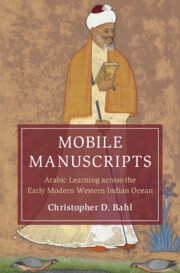Book contents
- Mobile Manuscripts
- Cambridge Oceanic Histories
- Mobile Manuscripts
- Copyright page
- Dedication
- Contents
- Figures
- Maps
- Tables
- Acknowledgements
- Notes on Dates, Places, and Transliterations
- Introduction
- 1 The Prosopographical World of Maritime Mobilities
- 2 The Royal Library of Bijapur
- 3 Arabic Philology in Early Modern South Asia
- 4 Mobile Arabic Learning from Egypt to the Deccan
- 5 From the Deccan to Istanbul
- Conclusion
- Appendix
- Bibliography
- Index
1 - The Prosopographical World of Maritime Mobilities
Published online by Cambridge University Press: 30 January 2025
- Mobile Manuscripts
- Cambridge Oceanic Histories
- Mobile Manuscripts
- Copyright page
- Dedication
- Contents
- Figures
- Maps
- Tables
- Acknowledgements
- Notes on Dates, Places, and Transliterations
- Introduction
- 1 The Prosopographical World of Maritime Mobilities
- 2 The Royal Library of Bijapur
- 3 Arabic Philology in Early Modern South Asia
- 4 Mobile Arabic Learning from Egypt to the Deccan
- 5 From the Deccan to Istanbul
- Conclusion
- Appendix
- Bibliography
- Index
Summary
The first chapter sets out the historical context of Arabic learning across the early modern western Indian Ocean by discussing people, practices, and places that constituted this field from the fifteenth to seventeenth centuries and how scholarship has engaged with this transregional formation so far. It explores Arabic and Persian narrative texts, such as collective biographies, from different regions of the western Indian Ocean to show how learned groups increasingly traversed the western Indian Ocean for scholarly pursuits during the fifteenth and sixteenth centuries, the centres of learning and text transmission that emerged and shifted over time, as well as the incentives such as patronage, career progression, and scholarly sociability that generated these mobilities. Contemporaries reflected on the transoceanic cultural connections that brought communities of the different regions together. From the sixteenth to the seventeenth centuries those transoceanic entanglements continued to shape this world, but changing political landscapes had an impact on the conditions of a transoceanic field of Arabic learning.
- Type
- Chapter
- Information
- Mobile ManuscriptsArabic Learning across the Early Modern Western Indian Ocean, pp. 39 - 68Publisher: Cambridge University PressPrint publication year: 2025

